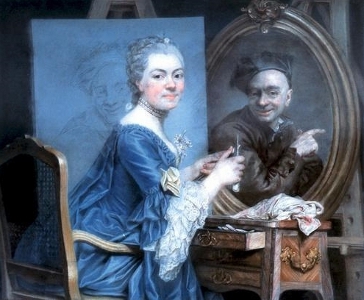Oil Painting : Composition
As I mentioned in my article Oil Painting Composition describing “Photo Selection“…
Choosing a photo of an interesting subject and portraying it in a way that enhances it’s attributes & the other parts contained within the image…or ‘composition’; is key to a successful oil painting. Since my style of painting attempts to recreate a photograph in as realistic a manner as possible, I avoid using images that don’t contain interesting elements, including texture, color, background, etc….since trying to execute an oil painting composition that lacks these qualities; will result in a less than desirable final product.
Consider the photo to the left and how it relates to oil painting composition…
titled: “Roslin Marie Suzanne: Self-Portrait”. This may look like an ordinary ‘Renaissance’ era painting, (I like it because it depicts a female artist at work…something that was not commonplace, yet apparently not unheard of during that time). However; if you look closely at what she is going to be painting, you’ll discover that the image in the mirror as well as the sketch she has on her canvas; are of a gentleman, instead of the “Self-Portrait” image of herself that should be visible in it; (in reality, it is an example of an obvious impossibility!). This illustrates one of the ways that an artist can choose to express their creativity by ‘manipulating’ different components in the design & one of the elements that can make an oil painting composition unique and thought-provoking.
That example illustrates another aspect of oil painting composition, in which the artist not only creates an interesting painting; but is also able to convey a message…. possibly as an attempt to fool the viewer.
Arrangement of the elements of an oil painting composition…
contained in the image and how the artist chooses to work with them, is a major part of creating a good oil painting composition. Of course there are several things to consider…
What is the main or primary subject, (or subjects)? In the case of an oil painting composition of a portrait containing more than one person, etc. it is necessary to decide which elements in the subject(s) need to be emphasized… such as: how the values in the image relate to each other, how light is affecting subjects or other elements in the image, and whether the colors compliment one another. One great thing about oil painting composition is that many of the elements can be changed to achieve the effect you would like, as long as you make sure that they have the correct value. Textures can be difficult to manage if there are more than one… however, you don’t want them competing with each other; and taking the focus off of the subject(s) you are trying to emphasize.
A word about secondary elements of an oil painting composition…
All the elements in a composition need to be considered. You as the artist & ‘composer’, have the ability to include or exclude which things contained in the original image that you feel will enhance the overall result; & you have control over deciding what you think will make it work. The only exception would be, that if you are doing a commissioned piece and whoever has commissioned you to do it; is adamant that they want to include certain elements. At that point you will need to consider whether doing so would be detrimental enough to the composition, that it would result in a painting that you would not want to sign your name to. You would then need to decide whether to accept or decline, depending on if you feel that it could affect your professional reputation.
If an image contains multiple subjects, and it appears very ‘busy’; due to there being too many elements competing against each other, there is another option… that is; to place the main subject into a different background. However; this is not recommended for novices, since being able to do this successfully depends on many factors; such as the ability to convey the correct perspective, as well as how to make sure that the subject would ‘fit’ into a different setting.
One option often used in portrait painting, is the use of one or just a few colors in a background. There are different techniques available to give it some interest, including: ‘feathering’ the edges, or using a variety of other textured effects. In the past, portraits usually had backgrounds that did not contain many elements; and this has changed somewhat recently, with the increase in popularity of people choosing to have a family portrait painted.

